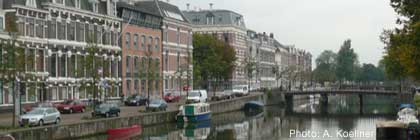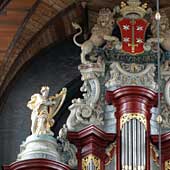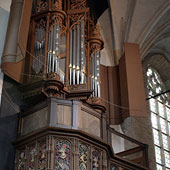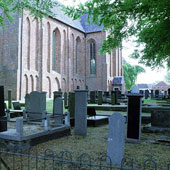 |
||
|
|
|
Celebrating the pipe organ, the King of Instruments |
About the Authors Michael Barone is the host of American Public Media’s long-running program Pipedreams. Richard Rasch is associate producer for Pipedreams. |
Notes from the Tour
May 6 – 18, The Netherlands

Day 1 - Monday, May 7

Everyone in the group converged at Schiphol airport, all accounted for and no lost luggage. At 11:30 we headed for Haarlem a quick lunch in a little café on the market square, and then visited one of the most imposing pipe organs in all the world at the Grote Kerk of Saint Bavo. Our tour guide Johan Stolk introduced Saint Bavo organist Jos van der Kooy who recounted the history of the instrument and demonstrated its persuasive powers. It’s easy to imagine this building three centuries ago, filled with important visitors during a mid week concert. Structures such as this served both civic and religious functions as market or convention centers during the week, then for church services on Sundays. Still today the Bavokerk employs two organists, one for religious gatherings and another for public recitals. The immensity of this space is difficult fully comprehend, so perfectly is the organ, with its 32 foot pedal towers, scaled to the overall building. Pictures of the organ case, which stands 98 feet tall and is still a good 20 feet off the floor, are known worldwide. The Bavo organ has attracted visitors since its inauguration. Both Handle and Mozart played on these keys as any interested members of our crew.
To keep people awake, we next visited the Catholic Saint Bavo Basilica with its three very different instruments, two in early 20th century Romantic style with electric action and the very modest chancel organ with mechanical action. Dr. Ton van Eck demonstrated them all most amiably. From there it was another hour to the Zuiderduin Hotel in Egmond aan Zee where we followed our evening meal with a quick, brisk walk to the seashore to watch the surf in the brief glow of a stormy sunset with a row 50 wind turbines spinning on the horizon. Then to bed for some well needed rest after an extended day of transatlantic travel and music adventure.
- Posted by Richard RaschDay 2 - Tuesday, May 8

Today some occasional sunshine made up for yesterday’s rain. What better way to up the ante after yesterday in Haarlem, than a visit to the Saint Laurenskerk in Alkmaar. Before hearing the incredible 1725 F. C. Schnitger of 56 stops, we listened in amazement to the diminutive van Covelens organ of 13 stops, restored to its original 16th century character. Its old pipes of nearly 100 percent lead speak with both a quiet rich vocal quality or, with more stops drawn, a brilliant intensity. How amazing to remember that this organ made music less than 20 years after Columbus stumbled upon the American continent; hearing this is indeed a trip back in time. The big organ, a blend of 17th and 18th century pipework, was made famous through recordings by the noted Bach specialist Helmuth Walcha. The architectural panache of its expansive case doors is most arresting. Pieter van Dijk provided historical background and a very satisfying demonstration of both after which those in our group brave enough were able to play the Schnitger.
Tuesday’s lunch was a free for all amidst the numerous small cafes in the vicinity of the market square of which the Laurenskerk is the central feature. Our bus then headed north over the dike that separates the Ijsselmeer from the North Sea, destination Leeuwarden, the capitol of the northwest province of Friesland. At the Jacobijnerkerk, Barone provided a mini-demo of the little Vermeulen choir organ while our ‘resident organist’ Arjen Leistra acclimated himself to the positions of the stops on the 1727 Müller organ (the instrument which, by its success, earned its builder the Bavokerk contract). After an improvisation on “Lobe den Herren” to showcase various combinations and solo registrations, Arjen thrilled our group with a feisty performance of Bach’s D-major Prelude and Fugue (S. 532). Though only a bit more than half as large as the Bavo organ, this Müller instrument is more ‘authentic’ in tone quality (less changed by rebuilders), and very exciting with its dense, throaty roar.
Not missing a beat, we continued to Groningen, stopping briefly for a demonstration by Stef Tuinstra at the relatively small Nieuwe Kerk, a boxy room with a 19th century instrument in an 18th century case, our impression of its somewhat gritty ensembles made better by some sweet sounding solo stops. Then we registered at the Eden City Hotel, dined next door at de Gulzige Kater (the ‘Greedy Cat’) and then, in intermittent rain, walked to the Martinikerk to hear a recital by Elly Kooiman. She first showed us the choir organ, originally a ‘positive’ division from a larger French instrument now equipped with new playing mechanism and filling the large choir space with a lively tone (the choir is used for services only during summer, as that area is not heated). We then moved into the expansive main church, and confronted another Dutch organ monument. This 1692 design by Arp Schnitger, which incorporates pipework from the 15th and 16th centuries, possesses the only remaining 32-foot Schnitger pedal principal. Schnitger’s son, Franz Caspar, further expanded the organ with the addition of a huge positive division. Ms. Kooiman’s program of works by Bach, Frescobaldi, Pachelbel and Böhm, explored virtually every resource. Tired after a long and strenuous day, yet thrilled beyond belief, we found our way back to the hotel for a nightcap and bed.
- Posted by Richard RaschDay 3 - Wednesday, May 9

Our travels today, under a sunny blue sky with puffy white clouds, took us into the countryside to the east of Groningen province, first to an almost untouched 1696 Schnitger organ in the village of Noordbroek. After walking though a grove of trees and surrounding cemetery, hearing birdsong and the wind in the branches above, one’s first impression inside this very old brick church, with its tall, narrow nave, is of musty antiquity. The organ likely has survived as well as it has through a lack of funds to ‘make things better’. But how could they be better, for despite the occasional flakes of ceiling plaster on the old wooden pews, this instrument sings with the vitality of youth and a sparkling energy. Time has not ‘stood still’ here…we have entered a time warp, where the qualities of this organ let music of Bach and Bruhns sound new again, and it’s easy to understand why organist Peter Westerbrink is so happy here.
Another half hour on the bus took us a bit west and north to Farmsum, where the ovular 19th century church is obviously much tidier. That the 1829 Lohman organ was moved to this ovular room (after an earlier building was demolished) is made obvious by the balcony railing that fences in the entire instrument, including its Rugwerk. Totally unfettered, fortunately, is the sound, still connected to the ‘classical’ Schnitger tradition, but with charming additions such as a liquid-toned Traverse Flute, succulent Gamba, and buzzy Vox Humana. Mendelssohn and Schumann works perfectly here (as Arjen demonstrates), but so do older scores.
From Farmsum a few more kilometers west (we’re up near the North Sea) to Zerijp, another small village with a huge old 11th century church and an organ reconstructed recently in a manner consistent with the extant 1651 case. The church is brick (so much of the old and new construction of the Netherlands is), but though the interior looks like brickwork, a large portion of it is coated with plaster over which the lines of brick mortar are painted. Our original intent had been for box lunches, but the hotel claimed an inability to provide same, so we took advantage of a McDonalds just outside Farmsum for a quick bite, taking a bit of a bite out of our timetable, but allowing us undivided attention to apply to Arjen’s recital.
From Zerijp we move a bit more west and south to Leens, where a single affluent donor paid for a large organ (27 stops) of uncommon splendor for a modest village church (Petruskerk). The case is jammed right up to the ceiling, and the sound is glorious, as Arjen again demonstrated.
From Leens, further westward to Leeuwarden (again), this time for supper (Restaurant Humphry), which was a really elegant place (lots of antique patina) but on many levels, making access for some of the ‘troubled walkers’ a bit difficult (also after a long hike in form the bus-drop). Another hike from the restaurant to the Oude Kerk/Jacobijnenkerk (which we visited on Tuesday to play the organ) for a concert by the exceptional Netherlands Chamber Choir. Their program of English Renaissance and early Baroque music (a cappella, with chamber organ, gamba and lute, Gibbons and Purcell) was sheer perfection. The hour-long coach ride back to Groningen rounded out an event-filled and most enjoyable day.
- Posted by Richard Rasch

